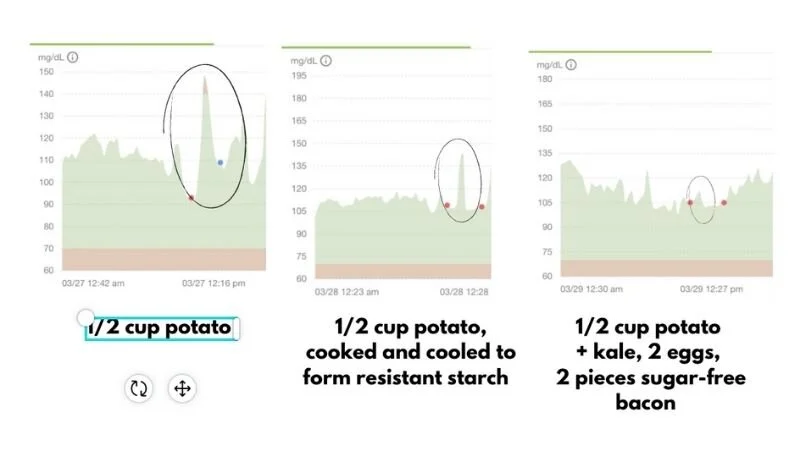Don't Eat Carbs Alone (My Month Wearing a CGM)
If you follow my work, you know that I can be a stickler about managing blood sugar. I believe that chronically elevated insulin is one of the main drivers of inflammation and chronic disease we see today. Not to mention, it’s very hard to stay lean with a constant surge of insulin running through the bloodstream! Check out my earlier post about insulin to learn more.
To take a deeper look at my own blood sugar, I decided to wear a continuous glucose monitor for 1 month. These cool little devices attach to your arm (painlessly) and measure blood sugar throughout the day.
Here are my main takeaways:
Blood sugar effect of starting the day with plain potato, potato with resistant starch formed, and potato as part of a meal.
Blood sugar effect of eating berries alone vs after a meal.
Don’t eat carbs alone. This has nothing to do with being antisocial. I’m talking about pairing the carbs with protein, fat and fiber to slow down digestion, preventing a rapid rise in blood sugar. Take a look at graphs (top row) where I ate potatoes by themselves vs. potatoes with a high fat, high fiber, high protein meal. The blood sugar response after the meal is far smaller, meaning it was much less stressful on the body, and much less likely to lead to fat storage (bacon for the win!). Also note the difference between berries alone (second row) and berries as a “dessert” after a high fat, high protein lunch. The timing made all the difference!
Resistant starch makes a difference, but not much. Resistant starch is a fiber that forms when a carbohydrate rich food like rice or potato is cooked and then cooled. Because it is not digested, it lowers the carb count and blood sugar response to that food. As you can see in the top row, my blood sugar response to the cooked and cooled potato was smaller than the regular potato, but not by much. Adding in the protein, fiber and fat made much more of a difference.
Blood sugar effect of drinking alcohol before dinner.
2. Don’t have a drink before a meal. I love a glass of wine or vermouth & seltzer on Friday night after I finish my admin work for the week. But after seeing the difference blood sugar from drinking on an empty stomach vs having a drink with dinner, I’ll be rethinking this habit. Notice: even though it was an indulgent restaurant dinner, the timing made all the difference!
Blood sugar effect of high fiber, high fat, high protein smoothie.
4. A high fiber, high fat, high protein smoothie is a fabulous breakfast. I start most days with a delicious smoothie (1 cup almond milk, 1 cup frozen greens, 2 Tbs nut butter 1 scoop protein powder, 1 Tbs chia or flax). I would have cried a little if this ritual had a negative affect on my blood sugar. Happily, it was the most consistently stabilizing meal I had (perfect “10” score every time!) This means it did not create any meaningful blood sugar spike or insulin release--which is a great thing. (NOTE: protein powders can have some pretty creepy ingredients. My favorite high quality brands are Be Well by Kelly for omnivores, and Foursigmatic for plant based folks).
As always, if you have any questions please don’t hesitate to reach out!




